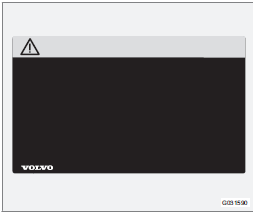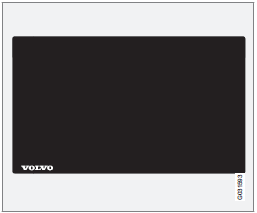Volvo XC60: Important information
Contacting Volvo
In the USA:
Volvo Cars of North America, LLC
Customer Care Center
1 Volvo Drive,
P.O. Box 914
Rockleigh, New Jersey 07647
1-800-458-1552
www.volvocars.us
In Canada:
Volvo Cars of Canada Corp
National Customer Service
175 Gordon Baker Road
North York, Ontario M2H 2N7
1-800-663-8255
www.volvocars.ca
About this manual
• Before you operate your vehicle for the first time, please familiarize yourself with the information found in the chapters "Your Driving Environment" and "During Your Trip."
• Information contained in the balance of the manual is extremely useful and should be read after operating the vehicle for the first time.
• The manual is structured so that it can be used for reference. For this reason, it should be kept in the vehicle for ready access.
Footnotes
Certain pages of this manual contain information in the form of footnotes at the bottom of the page. This information supplements the text that the footnote number refers to (a letter is used if the footnote refers to text in a table).
Display texts
There are several displays in the driver’s field of vision that show messages generated by various systems and functions in the vehicle.
These texts are indicated in the Owner’s Manual by being in slightly larger type than the surrounding text and are printed in gray, (for example: Change doors unlock setting).
Decals
There are various types of decals in the vehicle whose purpose is to provide important information in a clear and concise way. The importance of these decals is explained as follows, in descending order of importance.

Risk of injury
Black ISO symbols on a yellow warning background, white text/image on a black background.
Decals of this type are used to indicate potential danger. Ignoring a warning of this type could result in serious injury or death.

Risk of damage to the vehicle
White ISO symbols and white text/image on a black or blue warning background and space for a message. If the information on decals of this type is ignored, damage to the vehicle could result.

Information
White ISO symbols and white text/image on a black background. These decals provide general information.
NOTE
The decals shown in the Owner’s Manual
are examples only and are not intended to
be reproductions of the decals actually used
in the vehicle. The purpose is to give an indication
of how they look and their approximate
location in the vehicle. The applicable
information for your particular vehicle can
be found on the respective decals in the
vehicle.
Types of lists used in the manual
Procedures
Procedures (step-by-step instructions), or actions that must be carried out in a certain order, are arranged in numbered lists in this manual.
1 If there is a series of illustrations associated with step-by-step instructions, each step in the procedure is numbered in the same way as the corresponding illustration.
A Lists in which letters are used can be found with series of illustrations in cases where the order in which the instructions are carried out is not important.
1 Arrows with or without numbers are used to indicate the direction of a movement.
If there are no illustrations associated with a step-by-step list, the steps in the procedure are indicated by ordinary numbers.
Position lists
1 Red circles containing a number are used in general overview illustrations in which certain components are pointed out. The corresponding number is also used in the position list's description of the various components.
Bullet lists
Bullets are used to differentiate a number of components/functions/points of information that can be listed in random order.
For example:
• Coolant
• Engine oil
Continued
 This symbol
can be found at the lower right
corner of an odd-numbered (right-hand) page
to indicate that the current topic is continued
on the following page.
This symbol
can be found at the lower right
corner of an odd-numbered (right-hand) page
to indicate that the current topic is continued
on the following page.
Options and accessories
Optional or accessory equipment described in this manual is indicated by an asterisk.
Optional or accessory equipment may not be available in all countries or markets. Please note that some vehicles may be equipped differently, depending on special legal requirements.
Contact your Volvo retailer for additional information.
NOTE
• All information, illustrations and specifications
contained in this manual are
based on the latest product information
available at the time of publication.
• Volvo reserves the right to make model
changes at any time, or to change specifications
or design without notice and
without incurring obligation.
• Do not export your Volvo to another
country before investigating that country's
applicable safety and emission
control requirements. In some cases it
may be difficult or impossible to comply
with these requirements. Modifications
to the emission control system(s) may
render your Volvo not certifiable for
legal operation in the U.S., Canada and
other countries.
WARNING
If your vehicle is involved in an accident,
unseen damage may affect its drivability
and safety.
WARNING
CALIFORNIA proposition 65
Engine exhaust, some of its constituents,
and certain vehicle components contain or
emit chemicals known to the state of California
to cause cancer, and birth defects or
other reproductive harm. In addition, certain
fluids contained in vehicles and certain
products of component wear contain or
emit chemicals known to the State of California
to cause cancer, and birth defects or
other reproductive harm.
WARNING
Certain components of this vehicle such as
air bag modules, seat belt pretensioners,
adaptive steering columns, and button cell
batteries may contain Perchlorate material.
Special handling may apply for service or
vehicle end of life disposal.
See www.dtsc.ca.gov/hazardouswaste/perchlorate.
Shiftlock
When your vehicle is parked, the gear selector is locked in the P (Park) position. To release the selector from this position, the ignition must be in mode II (see page 82) or the engine must be running. Depress the brake pedal, press the button on the front side of the gear selector and move the selector from P (Park).
Anti-lock Brake System (ABS)
The ABS system performs a brief self-diagnostic test when the engine has been started and driver releases the brake pedal. Another automatic test may be performed when the vehicle first reaches a speed of approximately 6 mph (10 km/h). The brake pedal will pulsate several times and a sound may be audible from the ABS control module. This is normal.
Fuel filler door
Press the button on the light switch panel (see the illustration on page 268) when the vehicle is at a standstill to unlock the fuel filler door.
Please note that the fuel filler door will remain unlocked until the vehicle begins to move forward.
An audible click will be heard when the fuel filler door relocks.
Fuel filler cap
The fuel filler door, located on the right rear quarter panel, is connected to your vehicle's central locking system.
Points to keep in mind
• Do not export your Volvo to another country before investigating that country's applicable safety and exhaust emission requirements. In some cases it may be difficult or impossible to comply with these requirements. Modifications to the emission control system(s) may render your Volvo not certifiable for legal operation in the U.S., Canada and other countries.
• All information, illustrations and specifications contained in this manual are based on the latest product information available at the time of publication. Please note that some vehicles may be equipped differently, depending on special legal requirements.
Optional equipment described in this manual may not be available in all markets.
• Volvo reserves the right to make model changes at any time, or to change specifications or design without notice and without incurring obligation.
Vehicle event data (Black box)
Your vehicle's driving and safety systems employ computers that monitor, and share with each other, information about your vehicle's operation. One or more of these computers may store what they monitor, either during normal vehicle operation or in a crash or nearcrash event. Stored information may be read and used by:
• Volvo Car Corporation
• service and repair facilities
• law enforcement or government agencies
• others who may assert a legal right to know, or who
obtain your consent to know such information.
See also:
Media center 130 (RES) — AM/FM stereo radio with CD PLAYER (MP3 AUX jack)
NOTE: The radio sales code is located on the lower right
side of the radio faceplate.
Media Center 130 (RES)
Operating Instructions — Radio Mode
NOTE: The ignition switch must be in the ON or ACC
position to operate the radio.
Power Swit ...
Air cleaner element
Do not operate the engine with the
air cleaner element removed. The air
cleaner element not only filters
intake air but also stops flames if
the engine backfires. If the air
cleaner element is not installed
when the engine backfires, ...

 What to do if...
What to do if...